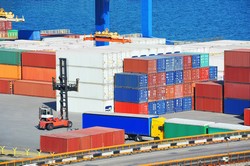Cutting-edge transportation system technology to better automate cargo handling at ports
Existing harbour and inland container terminals are presently limited by non-negligible, manually driven manoeuvres. Despite progress in autonomous vehicles, the benefits have not been so widespread in container handling. Moreover, the implemented automatised systems have needed substantial investment to equip terminal grounds with a grid of transponders that allow full control of optimised automated guided vehicles (AGVs). This large economic investment is preventing smaller terminals from adopting similar solutions. To address these issues, the EU-funded CARGO-ANTS(opens in new window) (Cargo handling by automated next generation transportation systems for ports and terminals) project set out to introduce automated next-generation transportation systems (ANTs). Specifically, project partners developed smart AGVs and automated trucks equipped with sensors that can cooperate in shared workspaces for efficient and safe freight transportation from and to cargo ships at main ports and freight terminals. These innovative ANTs are mainly designed for terminals that deal with large volumes of container traffic, but can be adapted to smaller terminals as well. They will reduce terminal congestion by increasing container throughput, widen the flexibility achievable on grid-independent infrastructure and significantly lower investment requirements. Researchers developed an automated, shared work yard for intelligent AGVs and automated trucks. Then, they created and demonstrated planning, decision, control and safety strategies for these vehicles. Lastly, the CARGO-ANTS team built and validated a robust grid-independent positioning system and an environmental perception system that oversees operational safety. In addition to port and terminal operators, CARGO-ANTS developments can serve the needs of other players in the logistics chain beyond container handling. These include warehouses and factories that have to move goods from one location to another on site, airports that are responsible for luggage transport, and the automotive industry that is working on future concepts for lots in open parking places.







